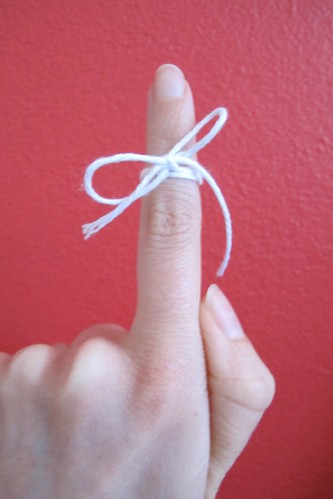
photo credit: A Reminder (license)
Mnemonics (pronounced /nəˈmɒniks/ with a silent ‘m’ at the beginning) are short devices (sayings, poems, etc) used to remember longer, more complex ideas or lists (also known as aides memoires or memory aides).
Think of them as poetic versions of string tied around your finger to help remember something!
A good example of a first letter mnemonic is:
Richard Of York Gave Battle In Vain
which is used to remember the colors of a rainbow in the order they appear:
- Red (Richard)
- Orange (of)
- Yellow (York)
- Green (gave)
- Blue (battle)
- Indigo (in)
- Violet (vain)
Spelling Mnemonics
These are mnemonics to help learn the spelling of sometimes difficult words.
- i before e except after c – although the rule is not very precise, it’s a good general rule for spelling.1
- WE Do Not Eat Soup Day – wednesday
- Rhythm Helps Your Two Hips Move Now – rhythmn
- Not Every Cat Eats Sardines (Some Are Really Yummy) – necessary
- To remember the start of beautiful: Big Elephants Are Ugly.
- Mrs M, Mrs I, Mrs S S I, Mrs S S I, Mrs P P I – Mississippi
Grammar Mnemonics
The following are mnemonics for grammar rules.
- A cat has claws at the end of its paws. A comma’s a pause at the end of a clause.
- OSASCOMP. Lists the order in which adjectives should appear: Opinion, Size, Age, Shape, Colour, Origin, Material, Purpose; this is also On Saturday And Sunday Cold Ovens Make Pastry.
- FANBOY are the coordinating conjunctions: for, and, nor, but, or, yet. Alternatively BOY SAT with BEN can produce: But, Or, Yet, So, And, Then, Both…and, Either…or, Neither…nor ).
* See the article, Adjective Order for more on this.
Parts of Speech in general are here:
Every name is called a NOUN,
As field and fountain, street and town;
In place of noun the PRONOUN stands,
As he and she can clap their hands;
The ADJECTIVE describes a thing,
As magic wand and bridal ring;
The VERB means action, something done –
To read and write, to jump and run;
How things are done, the ADVERBS tell,
As quickly, slowly, badly, well;
The PREPOSITION shows relation,
As in the street, or at the station;
CONJUNCTIONS join, in many ways,
Sentences, words, or phrase and phrase;
The INTERJECTION cries out, ‘Hark!
I need an exclamation mark!’
Through Poetry, we learn how each
of these make up the PARTS OF SPEECH.
Punctuation
For remembering that the quotation marks come after any other closing punctuation marks: P then Q in the alphabet.
When to start a new paragraph can be remembered using the following mnemonic:
Four “T”s, a little writing rhyme
Of Topic, Territory, Talker, Time
When there’s a change in one of these
Start a new paragraph if you please.
Useful Links
1 This article on concordancing examines the “i before e except after c” rule in more detail.



0 Comments